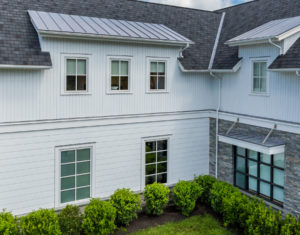
Best Practices for Vertical Siding
Combining horizontal and vertical siding is a great way to add interest and dimension to larger walls.
Vertical siding installation is on trend for a reason—blended with horizontal siding or other materials, it’s an ideal way to add dimension and visual interest to the home exterior, particularly as homeowners clamor for multi-textured façades. Vertical applications also are a great way to make accent areas a bit more interesting.
But installing vertical siding has some nuances both designers and installers should keep in mind. Here are a few things to consider when using TruExterior Siding in vertical installations.
- Choose the right style and profile: Vertical siding is most often used with Channel or V-Rustic profiles, but also can be achieved with Nickel Gap or Shiplap.
- Complement the home style: Vertical installations are commonly seen on both modern and traditional styles. If used across the full expanse of the façade, the look will decidedly lean modern or, depending on the other design elements, Modern Farmhouse; traditional exteriors should stick to accents, such as a gable or around an entryway.
- Follow installation instructions: Keep in mind that vertical installations of TruExterior Siding will require a few different steps than horizontal applications. These include:
- Make sure to install flashing above windows, doors, and roof lines as usual.
- If the height of the home requires more than one piece of siding installed vertically, create a belly band trim joint with a piece of 1×4, 1×6, or 1×8 trim (depending on preference) and Z-flashing above and below. In vertical applications, the belly band is the best strategy for optimal moisture management and is usually more visually effective versus having random seams.
- Fasten each piece of TruExterior Siding through the face, no less than 3/4″ from the edge and no more than 12″ along the length of both sides of the siding.
- Install a frieze board trim piece with flashing along the top edges of the siding under the soffits.
Want more industry tips and trends?


